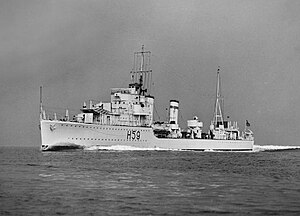HMS Gallant (H59)
 Gallant in April 1938
| |
| History | |
|---|---|
| Name | Gallant |
| Ordered | 5 March 1934 |
| Builder | Alexander Stephen and Sons, Glasgow |
| Laid down | 15 September 1934 |
| Launched | 26 September 1935 |
| Completed | 25 February 1936 |
| Identification | Pennant number: H59 |
| Motto | Nobis Mare Patria: 'The sea is our Fatherland ' |
| Fate | Sunk as a blockship, September 1943 |
| Badge | On a Field Blue, a female head proper crowned with scallops shells Gold. |
| General characteristics (as built) | |
| Class and type | G-class destroyer |
| Displacement |
|
| Length | 323 ft (98.5 m) |
| Beam | 33 ft (10.1 m) |
| Draught | 12 ft 5 in (3.8 m) |
| Installed power |
|
| Propulsion | 2 shafts, 2 geared steam turbines |
| Speed | 36 knots (67 km/h; 41 mph) |
| Range | 5,530 nmi (10,240 km; 6,360 mi) at 15 knots (28 km/h; 17 mph) |
| Complement | 137 (peacetime), 146 (wartime) |
| Sensors and processing systems | ASDIC |
| Armament |
|
HMS Gallant (H59) was a
in 1953.Description
Gallant displaced 1,350 long tons (1,370 t) at
deep load. The ship had an overall length of 323 feet (98.5 m), a beam of 33 feet (10.1 m) and a draught of 12 feet 5 inches (3.8 m). She was powered by Parsons geared steam turbines, driving two shafts, which developed a total of 34,000 shaft horsepower (25,000 kW) and gave a maximum speed of 36 knots (67 km/h; 41 mph). Steam for the turbines was provided by three Admiralty 3-drum water-tube boilers. Gallant carried a maximum of 470 long tons (480 t) of fuel oil that gave her a range of 5,530 nautical miles (10,240 km; 6,360 mi) at 15 knots (28 km/h; 17 mph). The ship's complement was 137 officers and men in peacetime,[1] but it increased to 146 in wartime.[2]
The ship mounted four 45-
21-inch (533 mm) torpedoes.[1] One rail and two depth charge throwers were fitted; 20 depth charges were originally carried, but this increased to 35 shortly after the war began.[3]
Service
Gallant was laid down by
Cape San Antonio on 6 April 1937, but was not damaged. The next month she returned to Great Britain for an overhaul at Sheerness between 31 May and 21 July 1937.[5]
When
armed merchant cruisers Cilicia and Carinthia after they collided. The ship was refitted at Southampton between 28 March and 30 April and rejoined her flotilla at Harwich the next day. During the evening of 9/10 May, Gallant and the destroyer Bulldog rescued most of the crew of the destroyer Kelly after the latter ship was torpedoed by a German E-boat in the North Sea.[6]
While Gallant was participating in the Dunkirk evacuation, a near miss by a bomb on 29 May knocked out her steering and caused minor damage to her hull and electrical systems. She was repaired at
12-pounder 3-inch (76 mm) anti-aircraft gun that replaced the rear torpedo tube mount.[6]
After her refit Gallant was transferred to the
Operation Collar.[6]
On 10 January 1941, during
hulk. Gallant was expended as a blockship at St Paul's Island in September 1943, with the wreck being broken up in 1953.[6]
Footnotes
References
- English, John (1993). Amazon to Ivanhoe: British Standard Destroyers of the 1930s. Kendal, England: World Ship Society. ISBN 0-905617-64-9.
- Nailer, Roger (1990). "Aircraft to Malta". In Gardiner, Robert (ed.). Warship 1990. London: Naval Institute Press. pp. 151–65. ISBN 1-55750-903-4.
- O´Hara, Vincent (2013). Struggle for the Middle Sea. London: Naval Institute Press. ISBN 978-1-61251-408-6.
- Rohwer, Jürgen (2005). Chronology of the War at Sea 1939–1945: The Naval History of World War Two (Third Revised ed.). Annapolis, Maryland: Naval Institute Press. ISBN 1-59114-119-2.
- Whitley, M. J. (1988). Destroyers of World War Two: An International Encyclopedia. Annapolis, Maryland: Naval Institute Press. ISBN 0-87021-326-1.
- Winser, John de D. (1999). B.E.F. Ships Before, At and After Dunkirk. Gravesend, Kent: World Ship Society. ISBN 0-905617-91-6.
